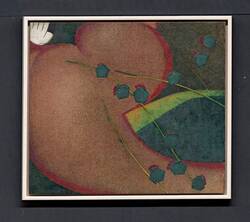From 1892 to 1897, Preissig studied at the School of Arts and Crafts in Prague [Vysoká škola umělecko-průmyslová v Praze]. After spending some time in Vienna and Munich, in 1898 he arrived in Paris, where he worked with Alfons Mucha and studied painting and graphic art techniques. In 1903 Preissig returned to Prague and earned his living as a printer. From 1905 he worked in his own studio, using the forms of the linear art nouveau style to illustrate books and design posters and advertising art. He founded the journal Česká grafika [Czech Graphic Art], became a member of the Mánes Association of Fine Artists and of the Hollar Association of Czech Graphic Artists. However, Preissig's financial difficulties eventually led to the judicial seizure of his studio. Shortly afterwards he emigrated with his wife and three daughters to the USA.
From 1912 to 1916, he taught in New York, first at the Art Students' League, then from 1914 at the Teachers' College of Columbia University. He became known as a typographer on account of his Preissig Antiqua typeface and he experimented with a variety of painting and printmaking techniques - assemblage, linocut, woodcut, etching, and mezzotint. His abstract
compositions resemble the later Op Art rather than the geometric abstraction that was popular at the time.
In 1931 he returned to Czechoslovakia, where exhibitions in 1931, 1933, and 1934 established his position as a pioneer and leading creator of Czech abstract art. Our exhibition presents a unique series of his paintings from the mid-1930s that border on abstraction, through which Preissig sought to depict biological or galactic movements, alluding to the genesis of life, the origin of the universe, or the fragile natural processes that permeate the Earth.
During the First World War, Vojtěch Preissig was involved in preparing for the foundation of an independent Czechoslovak state. While in the USA, he became personally acquainted with the future first President, Tomáš Garrigue Masaryk. From 1917, he worked for the New York branch of the Czechoslovak National Council, on whose behalf he led a recruitment campaign for the newly formed Czechoslovak Legions in France, and he designed posters and postcards with military and national themes. He was also the author of several (unrealised) designs for the flag of the future Czechoslovak state.
During the Second World War, he and his family joined the resistance against National Socialism. From 1939 to 1941, he organised the publication of the most important
underground resistance magazine V boj [Into the Fight], which he illustrated with anti-Nazi and patriotic drawings. In 1940 Preissig's resistance group was discovered by the Gestapo and arrested: his daughter Irena Bernášková was executed in 1942; after pre-trial detention in Goleniów in Poland, and then in Hamburg and Dresden, Vojtěch Preissig was sentenced to three years in prison. He was held in Bayreuth and Prague, before finally being transferred, in January 1944, to the Dachau concentration camp, where he died of typhoid fever that same year.
The abstract paintings by Vojtěch Preissig reflect the light emanating from biomorphic formations and are reminiscent of the Artificialist works of Štyrský and Toyen from their Paris period. In this exhibition, associations can be made with the organic sculptural forms of Dominik Adamec.
THREE ABSTRACT COMPOSITIONS,
1935–1937
b. 1873 in Světec / CZ
d. 1944 in Dachau concentration camp

